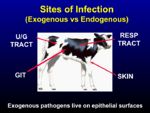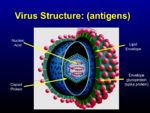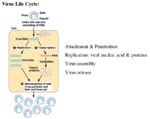Difference between revisions of "Host invasion by microorganisms"
| Line 37: | Line 37: | ||
*[[Vaccines - WikiBlood|Vaccines]] | *[[Vaccines - WikiBlood|Vaccines]] | ||
| + | Antibiotics cannot treat viral infection. While anti-viral therapies do exist, they are costly and often ineffective. The alternatives, therefore, include '''vaccination''' (priming the immune response to create memory lymphocytes for a particular virus) or '''eradication'''. | ||
=[[Bacteria - WikiBlood|Bacteria]]= | =[[Bacteria - WikiBlood|Bacteria]]= | ||
Revision as of 13:16, 21 August 2008
Introduction
Infection is a primary cause of disease. Three pathways of infection are identified: bacterial, viral, and parasitic. In all three cases, microorganisms can display similar characteristics. They can manifest as primary (obligate) pathogens or secondary (opportunistic) pathogens, the former of which always corresponds to disease, and the latter of which depends on prerequisites being fulfilled before causing disease. As such, secondary pathogens can be found in healthy animals, but they lie in wait until a primary cause compromises the immune system and then manifest symptoms. Secondary pathogens can even masquerade as commensal organisms, or those which operate in harmony with the animal, until they become pathogenic.
Microorganisms can enter the body by three routes: contact (typically dermatological infection), aerosol (typically respiratory infection), or orofecal (typically enteric infection). Infection can be either exogenous (via entry to epithelial surfaces) or endogenous (intracellular, extracellular, or vesicular).
Viruses
Structure
Viruses are very simple structures that do not carry any cellular machinery of their own. They depend on host cells to replicate and flourish. As such, their structure is streamlined, containing only:
- Genetic material, which consists solely of viral RNA
- Capsid proteins surrounding the RNA
- A lipid envelope
- Envelope glycoproteins (or spike proteins)
All of these elements can be recognized by the host as foreign material, and will provoke an immune response. Viruses have an advantage if they are able to penetrate host cell walls in that they are then capable of masquerading as host cells. The immune system must then counter by killing off host cells it recognizes as infected.
Replication
Viral lifespans have three distinct phases:
- Infectious (extracellular): as they seek out a host target
- Replicative (intracellular): as they overtake the host cell's utilities to multiply
- Dissemination (extracellular): as they leave the host cell and migrate to those surrounding
Routes of infection
Prevention and control
- Viral evasion of immunity
- Latency: Viruses can "hide" in host cells until the immune system is suppressed
- Transformation: the virus incorporates into the host genome, activating an oncogene, which causes cells to become neoplastic
- Adaptive Immunity to Viruses
The adaptive immune system has two main ways of dealing with viral infection: the first targets viruses in its initial extracellular phase, the second targets infected host cells. B-lymphocytes are capable of producing Antibody to neutralize the spike proteins of the viral lipid envelope. This adaptive response depends on CD4 TH-1 cells monitoring blood-borne pathogens and returning to lymph organs for presentation to B cells, and can take considerably longer than the second response. Cytotoxic (CD8+) T cells target infected cells, which present any number of danger signals. Once alerted to the infection, CD8+ T-cells will recruit help and proceed to wipe out all infected cells in the area.
Antibiotics cannot treat viral infection. While anti-viral therapies do exist, they are costly and often ineffective. The alternatives, therefore, include vaccination (priming the immune response to create memory lymphocytes for a particular virus) or eradication.


